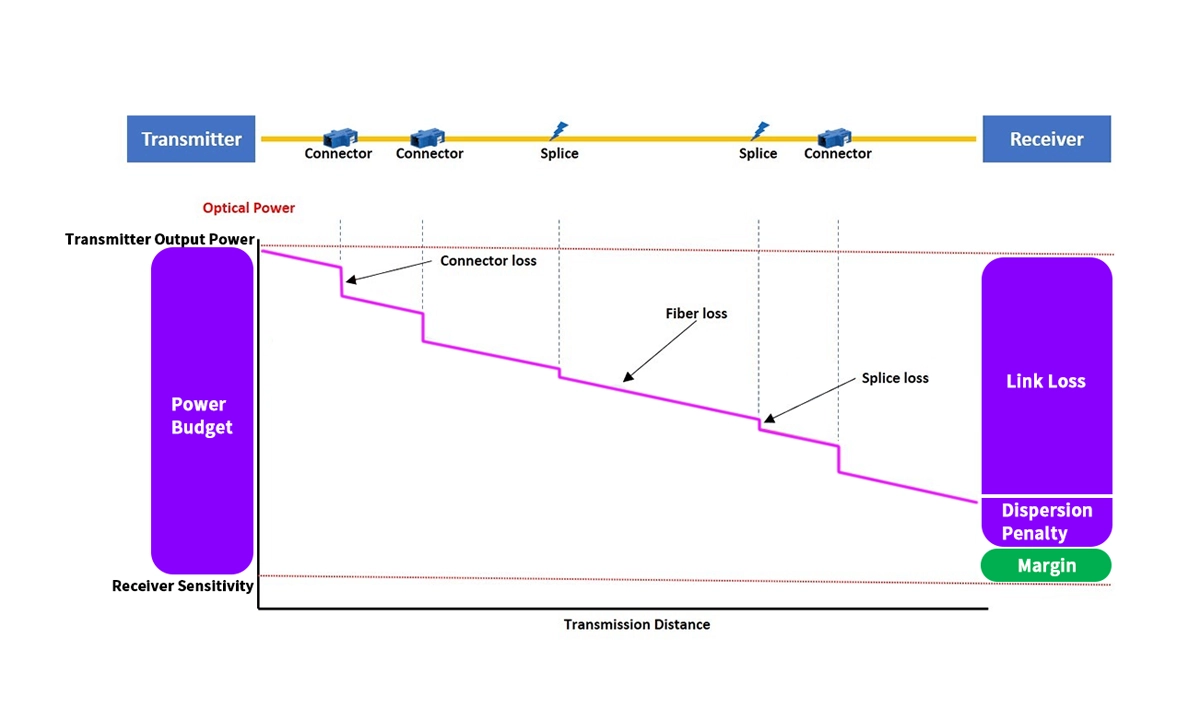
In the world of fiber optic networking, performance is everything. A single weak link can lead to slow data transfer, frequent dropouts, and costly downtime. At the heart of a stable and high-performing optical link lies a fundamental, yet often overlooked, concept: the Power Budget.
Think of it as the financial budget for your network's light signal. You have a certain amount of "light currency" (optical power) that you can spend from the transmitter to the receiver, accounting for all the "expenses" (signal losses) along the way. If you exceed your budget, the connection fails. This article will serve as your definitive guide to understanding, calculating, and mastering your network's optical power budget, ensuring your links are robust and future-proof.
We'll also dive into the pivotal role of optical transceivers and how a reliable partner like LINK-PP can provide the components you need for success.
📑 What Exactly is a Power Budget? Breaking Down the Basics
In technical terms, a Power Budget is the maximum allowable amount of signal loss (attenuation) between a light source (transmitter) and a detector (receiver) for a communication system to operate correctly. It is a cornerstone of fiber optic link design and is crucial for ensuring Bit Error Rate (BER) performance stays within acceptable limits.
The fundamental equation is simple:
Power Budget (dB) = Minimum Transmitter Power (dBm) - Minimum Receiver Sensitivity (dBm)
This calculated value represents the total amount of loss your link can tolerate. Your actual link loss must be less than this value for a stable connection.
📑 The Critical Role of Optical Transceivers in Your Power Budget
When discussing power budget in fiber optic networks, the optical transceiver is the star of the show. It's the module that converts electrical signals to light and back again. Its specifications directly define the two most critical variables in our power budget equation.
Transmitter Output Power: How much light is launched into the fiber.
Receiver Sensitivity: The minimum amount of light required at the receiver to correctly interpret the signal.
Choosing the right transceiver is not just about compatibility; it's about matching its power characteristics to your link's requirements. For instance, using a transceiver with low output power for a long-distance link with high loss is a recipe for failure. This is where understanding the power budget requirements for SFP, SFP+, and QSFP modules becomes essential for network engineers.
A Closer Look with LINK-PP
Let’s consider a real-world scenario. You are designing a 10-kilometer link for a data center backbone. After calculating your total estimated loss, you need a transceiver that provides a sufficient power budget margin.
This is an ideal application for the LINK-PP SFP-10G-LR module. This high-performance 10G SFP+ optical transceiver is engineered for long-reach applications up to 10km. Its robust power specifications ensure a healthy power budget, even in challenging environments.
The table below illustrates how the LINK-PP SFP-10G-LR fits into a typical power budget calculation:
Component / Parameter | Value | Description |
|---|---|---|
LINK-PP SFP-10G-LR Min. Output Power | -8.2dBm | The weakest signal launched into the fiber. |
LINK-PP SFP-10G-LR Receiver Sensitivity | -14.4dBm | The minimum signal it needs to operate. |
Calculated Power Budget | 6.2dB | (-8.2) - (-14.4) = 6.2 dB of available loss. |
Typical Link Loss (10km SMF + connectors) | ~3.5dB | Estimated loss from fiber and connections. |
Power Margin | 2.7dB | 6.2 dB - 3.5 dB = 2.7 dB of safety margin. ✅ |
As shown, the LINK-PP module provides a comfortable margin, ensuring long-term reliability even if connector cleanliness degrades slightly over time. When you're looking for reliable optical transceivers for high-power budget links, this level of performance is exactly what you need.

📑 How to Calculate Your Link's Power Budget: A Step-by-Step Guide
Calculating your power budget isn't just about the transceiver. You must account for all elements that contribute to signal loss. Here’s a practical step-by-step process for calculating power budget for a fiber optic link:
Identify Transceiver Specifications: Obtain the minimum transmitter power and minimum receiver sensitivity from your transceiver datasheet (e.g., the LINK-PP SFP-10G-LR specs above).
Calculate System Power Budget: Use the formula: Power Budget = transmitter power - receiver sensitivity
Calculate Total Link Loss (Channel Loss): Sum the losses from all sources:
Fiber Attenuation: Length (km) × Attenuation Coefficient (dB/km). For standard Single-Mode Fiber (SMF), use 0.4dB/km.
Connector Loss: Number of connector pairs × Loss per pair (typically 0.75dB per mated pair).
Splice Loss: Number of splices × Loss per splice (typically 0.1 to 0.3dB each).
Design Margin: Always include a safety margin (3dB is common) for aging, temperature variations, and future repairs.
Ensure a Positive Margin: Your total link loss must be less than the system power budget. Power Margin = Power Budget - Total Link Loss. A positive margin indicates a viable link.
📑 Common Power Budget Pitfalls and How to Avoid Them
Even with a good calculation, networks can fail. Here are common mistakes:
Ignoring the Design Margin: This is not optional. It's your buffer against real-world unpredictability.
Mixing Incompatible Components: Using a multi-mode transceiver with single-mode fiber, or vice versa, will result in catastrophic loss.
Poor Installation Practices: Dirty connectors are the #1 cause of unexpected high loss. A single fingerprint can consume your entire budget!
Overlooking Dispersion: For very high-speed or long-haul links, chromatic dispersion can degrade the signal, effectively reducing the usable power budget.
📑 Conclusion: Power Budget is Your Blueprint for Success
A thorough understanding and accurate calculation of your fiber optic power budget is not just an academic exercise—it's the blueprint for a reliable, high-speed network. It dictates the choice of every component, especially the optical transceivers that serve as the heart of your data links.
By partnering with manufacturers that provide clear, reliable specifications and robust products—like the LINK-PP SFP-10G-LR—you can design with confidence, ensuring your network not only works on day one but continues to perform flawlessly for years to come.
📑 FAQ
What is a power budget?
A power budget shows you how much energy your system needs. You use it to make sure your devices get enough power.
What happens if you go over your power budget?
Your devices might shut down or stop working. You could damage your equipment. Always check your power budget before adding new devices.
What do you need to calculate a power budget?
You need a list of your devices, their power use in watts, and your total power supply. Add up the numbers to see if you have enough.


